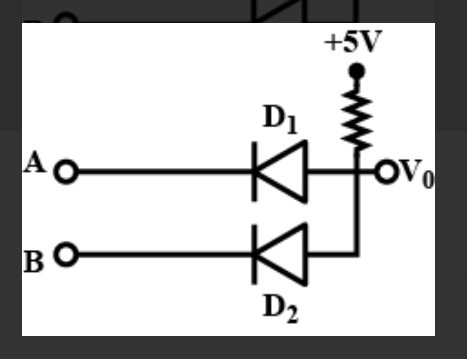Answer
35.1k+ views
Hint: We know that logic gates perform basic logical functions and are the fundamental building blocks of digital integrated circuits. Most logic gates take an input of two binary values, and output a single value of a 1 or 0. Some circuits may have only a few logic gates, while others, such as microprocessors, may have millions of them. Boolean logic is a very easy way to figure out the truth of an expression using the simple concept of true or false. In a nutshell, Boolean logic means you are working with stuff that is either TRUE or FALSE (and nothing else as Monty Python would say).
Complete step by step answer
We know that Logic gates are the basic building blocks of any digital system. It is an electronic circuit having one or more than one input and only one output. The relationship between the input and the output is based on a certain logic. Based on this, logic gates are named as AND gate, OR gate, NOT gate etc. Digital electronics relies on the actions of just seven types of logic gates, called AND, OR, NAND (Not AND), NOR (Not OR), XOR (Exclusive OR) XNOR (Exclusive NOR) and NOT. Because, in binary logic there are only two states, 1 and 0 or 'on and off,' NOT in the world of binary logic therefore means 'the opposite of'.
The circuit resembles an AND gate. The Boolean expression of this
circuit is $\mathrm{V}_{0}=\mathrm{A.B}$ that is $\mathrm{V}_{0}$ equals A AND B.
The truth table is given below:
So, the correct answer is option B.
Note: We can conclude that the AND gate is so named because, if 0 is called "false" and 1 is called "true," the gate acts in the same way as the logical "and" operator. The output is "true" when both inputs are "true." Otherwise, the output is "false." In other words, the output is 1 only when both inputs one AND two are 1. When a transistor is on, or open, then an electric current can flow through. When we string a bunch of these transistors together, then we get what's called a logic gate, which lets you add, subtract, multiply, and divide binary numbers in any way imaginable. In a physical circuit, these logic gates have: Inputs.
Complete step by step answer
We know that Logic gates are the basic building blocks of any digital system. It is an electronic circuit having one or more than one input and only one output. The relationship between the input and the output is based on a certain logic. Based on this, logic gates are named as AND gate, OR gate, NOT gate etc. Digital electronics relies on the actions of just seven types of logic gates, called AND, OR, NAND (Not AND), NOR (Not OR), XOR (Exclusive OR) XNOR (Exclusive NOR) and NOT. Because, in binary logic there are only two states, 1 and 0 or 'on and off,' NOT in the world of binary logic therefore means 'the opposite of'.
The circuit resembles an AND gate. The Boolean expression of this
circuit is $\mathrm{V}_{0}=\mathrm{A.B}$ that is $\mathrm{V}_{0}$ equals A AND B.
The truth table is given below:
| A | B | Y |
| 0 | 0 | 0 |
| 0 | 1 | 0 |
| 1 | 0 | 0 |
| 1 | 1 | 1 |
So, the correct answer is option B.
Note: We can conclude that the AND gate is so named because, if 0 is called "false" and 1 is called "true," the gate acts in the same way as the logical "and" operator. The output is "true" when both inputs are "true." Otherwise, the output is "false." In other words, the output is 1 only when both inputs one AND two are 1. When a transistor is on, or open, then an electric current can flow through. When we string a bunch of these transistors together, then we get what's called a logic gate, which lets you add, subtract, multiply, and divide binary numbers in any way imaginable. In a physical circuit, these logic gates have: Inputs.
Recently Updated Pages
To get a maximum current in an external resistance class 1 physics JEE_Main

f a body travels with constant acceleration which of class 1 physics JEE_Main

A hollow sphere of mass M and radius R is rotating class 1 physics JEE_Main

If the beams of electrons and protons move parallel class 1 physics JEE_Main

Two radioactive nuclei P and Q in a given sample decay class 1 physics JEE_Main

If a wire of resistance R is stretched to double of class 12 physics JEE_Main

Other Pages
Oxidation state of S in H2S2O8 is A 6 B 7 C +8 D 0 class 12 chemistry JEE_Main

A closed organ pipe and an open organ pipe are tuned class 11 physics JEE_Main

Excluding stoppages the speed of a bus is 54 kmph and class 11 maths JEE_Main

The mole fraction of the solute in a 1 molal aqueous class 11 chemistry JEE_Main

Dissolving 120g of urea molwt60 in 1000g of water gave class 11 chemistry JEE_Main

Differentiate between homogeneous and heterogeneous class 12 chemistry JEE_Main




